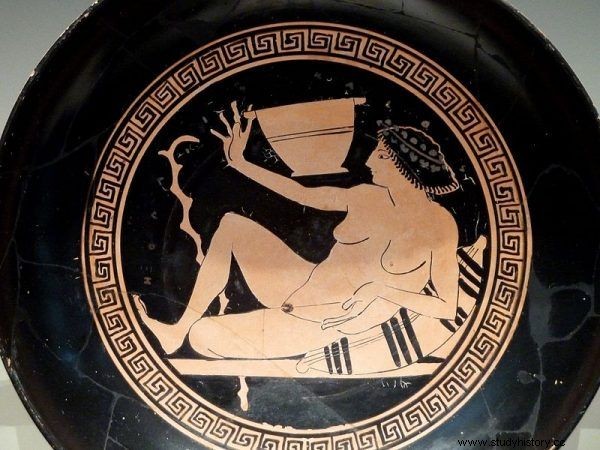It was most often started in childhood. Harlotry was practiced not only by female slaves, but also by free and even married women. Under the "care" of pimps, they waited for customers at homes, on the streets, and often in cemeteries. To fulfill every whim of a man ...
In "Iliad" and "Odyssey" - which refer to earlier centuries and at the same time show the realities of the author's era - there are no specialists in paid love, only captives and mistresses. Prostitution appears in Hellas after Homer in a rather unusual form. In Corinth, at the temple of the goddess of love, Aphrodite.
As reported by the Greek historian Strabo (63 BCE - 24 CE), was serving over a thousand hierodul , sex slaves, thanks to which the followers "connected" with the goddess. They were placed there as a gift from the faithful. For example, a certain Xenophone purchased in the 5th century BC. one hundred women whom he offered to Aphrodite in thanks for the victory at the Olympics. A similar sanctuary with temple prostitution was also supposed to exist on Mount Eryks - in Sicily, colonized by settlers from Hellas.
Unfortunately, archaeologists have not yet identified clear, convincing traces of these giant sex temples. Maybe the facts about them were blown away? Anyway, when Xenophon was going to fund a herd of his hieroduli , ordinary paid prostitution was already flourishing in the streets of Greek cities.
You can choose a color
There is a belief that the first brothel was founded in Athens by the legislator Solon (7th-6th centuries BCE), and the slaves whose bodies were trafficked there took only one pain for their services (that is, as much as a loaf of bread cost). They were provided with maintenance, as long as they did everything the clients wanted. If they were satisfied, the authorities felt a job well done.
“So come on in, no one is going to pretend or hide anything from you, nor is anyone going to make an ado. Those you choose will embrace you in their arms whenever and however you want "- described the poet Philemon at the turn of the 4th and 3rd century BC. "There are beautiful girls you can have for little money without risking your health," added comedy writer Eubulos.

Prostitution probably began in the temple of the goddess of love… it turned out, paid. Pictured is Bronzin's painting of Venus with Cupid.
However, competition quickly developed in the market. A common prostitute was called porne, and the more expensive and more educated one was defined by the aforementioned term hetaira , that is, "companion of men." In practice, however, often all women who made paid love were called heteras, although there were also other names, such as dictatorias or flautists.
They did not have to be tied to any temple anymore, could work at home, on the street, in porticoes of buildings or even in cemeteries - often under the "care" of the pimper . The brothels were owned by both Athenian citizens and foreigners residing in the city. There is information that a certain Euktemon owned a whole network of brothels in the port of Piraeus and in the potters' district, Kerameikos. His Athenian tabernacle, near the Holy Gate, consisted of ten small rooms and a central courtyard. There was no shortage of customers:young and old Athenians, sailors and merchants banged on doors and windows. The Kerameikos district was considered a great place for sexual hunting. Some Athenians, however, loudly voiced their indignation at the corruption of morals. They complained:
Young people are doing terrible and unbearable things in our city. At every step you can see beautiful girls standing in the sun in front of brothels, dressed in transparent dresses and tempting with exposed breasts. You can choose what you want - skinny or fat, plump or limp, beautiful or ugly, young, mature or old - and you don't have to set up a ladder to get to it secretly, or slide through a hole in the roof or also hide in a pile of straw. They almost forcibly drag you home and call you daddy if you are old, or a teenager or a brother - if you are young, and you can take each of them without risk for pain, both during the day and at night .

This article was written during the author's work on the book "Ages of shamelessness. Sex and erotica in antiquity ”
Such an exhibition with naked women, reminiscent of Amsterdam's red light district, did not work for all men. Some preferred girls in colorful robes and blonde wigs. On the other hand, elegant heterosexuals, dealing with a better clientele, opted for transparent robes and shawls. Firstly, they looked like respected citizens (which added spice to the whole thing), and secondly, they stimulated the imagination of men.
The German historian and archaeologist Carola Reinsberg recalls the example of a painting from a vessel showing, with a pinch of salt, the "negotiations" between the client and heta. First, the man lifts her gown from the front, checking the "quality of the merchandise". Then - either agitated or dissatisfied with what the front lady looked like - he turns her over and pampers her back with her body without even taking off her dress .
Legend of heter
In addition to slaves, liberating women and free foreigners also took part in the Athenian sex business. It is possible that even some married women were clandestinely practiced in Greece. Careers in brothels began practically at the age - from our point of view - as a child. Tormentors didn't care about immaturity. Supposedly there were even schools of fornication!

Vase paintings are a good source of information about prostitution in ancient Greece. The image inside the kylix shows Hetera playing the "drinking game" known from symposiums.
With the ancient practice of abandoning unwanted newborns, there was no shortage of "goods" for pimps. It was enough to go to the forest and then invest very little in raising a child. From a trial around 340 B.C.E. against the prostitute Neajra - accused of illegally claiming to be the wife of an Athenian - you can find out about the hetaera way in life.
As a child, Neajra was bought by a freedman and worked in brothels in Corinth. Over time, she became a well-paid professional. She managed to buy it out, but she did not give up the sex business. She hooked up with the wrong men, and eventually got into a long relationship with a respected Athenian. From the past, however, there was no escaping…
Even the most famous of the courtesans - for example Lamia, who entertained the ruler of Egypt Ptolemy I Soter and the king of Macedonia Demetrius Poliorketes - were accompanied by a feeling of reluctance, suspicion or even contempt. Which does not mean that at least some of the heers did not enjoy some respect, were involved in social matters or even in politics (Aspasia was involved in the armed conflicts of Athens with Megara and Samos). In fact, some have sumptuous monuments and temples (such as Pythionike, Harpalos' mistress - treasurer of Alexander the Great, or Belestiche, Ptolemy II's lover).

Some heera had a real career. They published sex guides, engaged in politics, and even became women of Athenian chiefs. Pictured is a painting by Jean-Léon Gérôme depicting the process of Fryne, the most famous Greek heta.
"Greek prostitutes, in whom one could always discern some remnant of affection and a dream of perfect love, never fully opened themselves to all degenerations coming from abroad and always kept a certain reserve against the most hideous perversions, while Roman harlots assimilated all of them" - suggests 19th-century bibliophile and journalist Paul Lacroix in The History of Prostitution (published under the name of Dufour). However, if we confront his opinion with how the services of prostitutes at symposiums are presented in vase paintings, the romantic charm of Greek heterosexuals is lost. Unless, of course, these were only deliberately shocking products, made for a specific clientele or for export.
Maybe Greek vases were not the best method of sexual education, but at least some prostitutes contributed to the awareness of the ancients. Hetera's past was behind Filenis of Samos (4th-3rd century BC), author of a popular ancient sex-guide. And probably also another "Michalina Wisłocka of antiquity" - Elephantida. Better known as a midwife and doctor, in the 1st century B.C.E. has published her own textbook with an overview of sexual positions. Decorated with illustrations, he made a career in imperial Rome. Of course, the Romans hardly ever used it in their matrimonial bedrooms, but they often took advice when playing with slaves and "professionals."
***
The text was created during the author's work on his latest book. " Ages of shame. Sex and erotica in antiquity ” .
